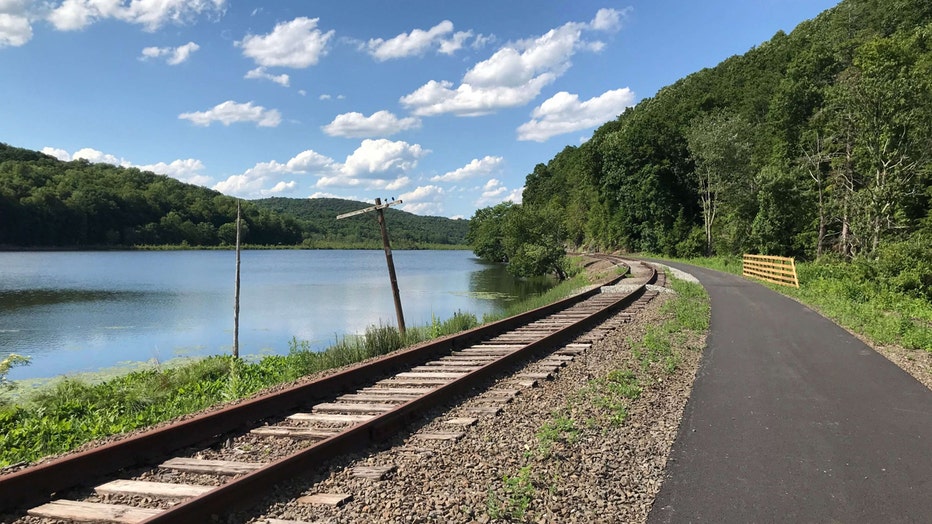New York's 750-mile Empire State Trail completed
A map of the Empire State Trail in New York. (Screenshot via empiretrail.ny.gov/ESRI) | Click here for the interactive map
NEW YORK - New York state has finished work on a 750-mile trail for cyclists, hikers, and runners that spans the state from New York City to Canada, and from Albany to Buffalo.
The Empire State Trail is expected to attract 8.6 million residents and tourists a year, Gov. Andrew Cuomo said this week. Completing the trail involved building more than 180 miles of new off-road trail and connecting 400 miles of existing trails, his office said.
The EST's north–south branch runs from Battery Park in Manhattan through the Hudson Valley and Champlain Valley to the Canadian border just north of Rouses Point. The east–west branch of the trail breaks off in Cohoes, follows the Mohawk River and then the Erie Canal, and leads to Buffalo Harbor State Park on the shore of Lake Erie.
"There's no trail like it in the nation," Cuomo said in a news release. "Not only does it provide an opportunity to experience the natural beauty and history of New York, but it also gives New Yorkers from every corner of the state a safe outlet for recreation as we continue to grapple with the COVID-19 pandemic."
Users of the trail can peruse the Empire State Trail website for interactive maps, segment descriptions, access points, trail distances, parking areas, restrooms, amenities, and attractions along and near the trail.
Several recently completed projects effectively connected dozens of existing trails that are part of the Hudson Valley Greenway Trail, Erie Canalway Trail, and Champlain Valley Trail systems, unifying them under the Empire State Trail brand. (Story continues)

A section of the Maybrook Trailway, which is part of the Empire State Trail, next to Ice Pond in Putnam County, N.Y. (Photo via empiretrail.ny.gov)
Get breaking news alerts in the FOX 5 NY News app. Download for FREE!
These are summaries of the major projects for the trail, as provided by the office of the governor:
Hudson Valley
Albany-Hudson Electric Trail: The Hudson River Valley Greenway constructed 36 miles of off-road and on road trails from the city of Rensselaer to the City of Hudson in Rensselaer and Columbia counties. The $45 million trail follows the historic route of an electric trolley which operated from 1900 to 1929. The corridor is owned by National Grid, which authorized New York State to build a trail on the route.
Maybrook Trailway: Metro-North Railroad constructed a new 23-mile rail-trail on its inactive "Beacon Line" corridor from Hopewell Junction in Dutchess County to Brewster in Putnam County passing through the towns of Pawling, Southeast, Paterson, Beekman and East Fishkill. Along the route, the trail winds through rural landscapes and wooded areas featuring seasonal waterfalls and crosses the Appalachian Trail. The $42 million Beacon Line was the first all-rail freight connection across the Hudson River north of New York City. It originally opened as a rail line in 1892 and served as a vital transportation link between New York and southern New England, carrying trains between Derby Junction and Maybrook, via the bridge over the Hudson River at Poughkeepsie that is now the Walkway Over the Hudson.
Hudson River Brickyard Trail: The City of Kingston constructed a new 1.5-mile Empire State Trail section along the Hudson River shoreline. The $1.4 million project was built with City of Kingston and Town of Ulster funds matched by state grants from the Department of State and Hudson River Valley Greenway.
Battery Park City Gateway: The $450,000 gateway marks the southern terminus of the trail in Lower Manhattan.
Erie Canalway Trail
The Ralph C. Wilson Jr. Gateways: These four gateways in Western New York provide a welcoming connection for trail visitors at key access points in: Buffalo Harbor State Park in Buffalo; at the western entrance to the Erie Canal in Tonawanda; at Five Locks Park in Lockport; and in Genesee Valley Park in Rochester. The gateways include kiosks featuring local and statewide trail information, bicycle racks, and shaded granite block seating. Each gateway features a "Ralph C. Wilson, Jr." memorial plaque honoring the late owner of the Buffalo Bills. The Ralph C. Wilson, Jr. Foundation provided $2.6 million dollars for the gateways.
Macedon Bridge: NYSDOT restored a closed vehicle bridge over the Erie Canal. The $4.2 million investment created a bicycling and walking trail and created a local park.
Erie Blvd-Syracuse: NYSDOT constructed a 3-mile trail in the median of Erie Blvd, from East Syracuse to DeWitt. The project cost $23 million.
Loop the Lake Trail-Syracuse: Onondaga County constructed a new 1.5-mile trail on the south shore of Onondaga Lake, including a new bicycle/pedestrian bridge over CSX's rail line. The project was funded with County and federal funds.
Utica: New York State Canal Corporation constructed a new 3.5-mile trail east of Utica for $9.3 million
Herkimer County: New York State Canal Corporation completed a new 2.2-mile trail section Lock E18 to Route 167, a new 1.3-mile trail section Frankfort to Ilion, and a new 2-mile trail from Ilion to Mohawk. These projects totaled $16.4 million.
Champlain Canalway
Fort Edward to Fort Ann: The New York State Canal Corporation constructed two adjacent trail sections. The $14.3 million investment created a 12-mile trail from Fort Edward to Fort Ann.
Fort Ann to Comstock: NYSDOT built a new 0.75-mile off-road trail in Washington County and designated a 7-mile route on local roads and cost $2 million.
With The Associated Press

